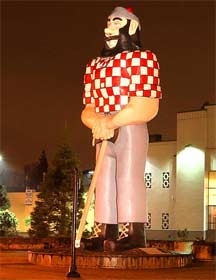Tall (and small) tales

It was quite a sight to see, that cook of Paul Bunyan's making flapjacks. ...The table we had set up for the camp was about ten miles long. We rigged elevators to the table to bring the vittles to each end, and some of the younger lads in the camp rode bicycles down the path at the center, carrying cakes and such wherever they were called for.
(Legends of Paul Bunyan, as retold by S. E. Schlosser)
According to various sources, Paul Bunyan combed his beard with a 100 foot pine tree, cooked his pancakes on a stove that was 160 feet tall, and caused miles of destruction every time he sneezed.
So (for those of you not born in one of the states claiming to be the birthplace of Paul Bunyan), who was this guy? I'm guessing it's pretty clear to everyone that all of this is a tall tale. Why? It's not just the ridiculous fiberglass statues in at least 3 Minnesotan towns! It's not just the claim of one "museum" to have Paul Bunyan's fingernail clippings!
No, I'm guessing you knew it right away because you know that kitchen stoves aren't 160 feet tall, and hair combs aren't 100 feet long.
From your everyday life, not to mention the efforts of your elementary school teachers, you have an intuitive sense of what a foot, an inch, and a mile look like.
Now that you're studying biology, you need to develop the same intuitive sense of what a millimeter, a micrometer, and a nanometer look like.
The hard part is that, while we can see an inch, things that are on the order of millimeters are kinda small, things on the order of micrometers can rarely be seen directly, and nanometers — you might as well forget seeing them without a really good microscope.
Nevertheless, we're going to try to divide up the biological world into these scales and do what we can. Before we start, it will be helpful to have a ruler (or anything else that can easily measure millimeters) and a calculator on hand.
Ready? OK, let's go.
Copyright University of Maryland, 2007
You may link to this site for educational purposes.
Please do not copy without permission
requests/questions/feedback email: mathbench@umd.edu